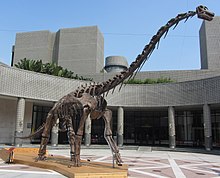
Titanosaurs were a diverse group of sauropod dinosaurs, including genera from all seven continents. The titanosaurs were the last surviving group of long-necked sauropods, with taxa still thriving at the time of the extinction event at the end of the Cretaceous. This group includes some of the largest land animals known to have ever existed, such as Patagotitan—estimated at 37 m (121 ft) long with a weight of 69 tonnes —and the comparably-sized Argentinosaurus and Puertasaurus from the same region.
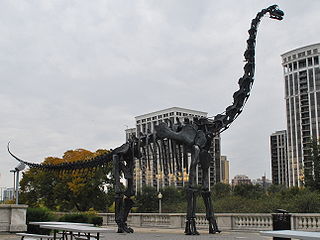
The Brachiosauridae are a family or clade of herbivorous, quadrupedal sauropod dinosaurs. Brachiosaurids had long necks that enabled them to access the leaves of tall trees that other sauropods would have been unable to reach. In addition, they possessed thick spoon-shaped teeth which helped them to consume tough plants more efficiently than other sauropods. They have also been characterized by a few unique traits or synapomorphies; dorsal vertebrae with 'rod-like' transverse processes and an ischium with an abbreviated pubic peduncle.

Macronaria is a clade of sauropod dinosaurs. Macronarians are named after the large diameter of the nasal opening of their skull, known as the external naris, which exceeded the size of the orbit, the skull opening where the eye is located. Fossil evidence suggests that macronarian dinosaurs lived from the Middle Jurassic (Bathonian) through the Late Cretaceous (Maastrichtian). Macronarians have been found globally, including discoveries in Argentina, the United States, Portugal, China, and Tanzania. Like other sauropods, they are known to have inhabited primarily terrestrial areas, and little evidence exists to suggest that they spent much time in coastal environments. Macronarians are diagnosed through their distinct characters on their skulls, as well as appendicular and vertebral characters. Macronaria is composed of several subclades and families notably including Camarasauridae and Titanosauriformes, among several others. Titanosauriforms are particularly well known for being some of the largest terrestrial animals to ever exist.

Andesaurus is a genus of basal titanosaurian sauropod dinosaur which existed during the middle of the Cretaceous Period in South America. Like most sauropods, belonging to one of the largest animals ever to walk the Earth, it would have had a small head on the end of a long neck and an equally long tail.

Huabeisaurus was a genus of dinosaur from the Late Cretaceous. It was a sauropod which lived in what is present-day northern China. The type species, Huabeisaurus allocotus, was first described by Pang Qiqing and Cheng Zhengwu in 2000. Huabeisaurus is known from numerous remains found in the 1990s, which include teeth, partial limbs and vertebrae. Due to its relative completeness, Huabeisaurus represents a significant taxon for understanding sauropod evolution in Asia. Huabeisaurus comes from Kangdailiang and Houyu, Zhaojiagou Town, Tianzhen County, Shanxi province, China. The holotype was found in the unnamed upper member of the Huiquanpu Formation, which is Late Cretaceous (?Cenomanian–?Campanian) in age based on ostracods, charophytes, and fission-track dating.
Gobititan is a genus of herbivorous sauropod dinosaur from the Aptian faunal stage of the Early Cretaceous. The name of this genus is derived from the Gobi desert region and the Titans of Greek mythology, which is a reference to its large body size. The specific name shenzhouensis, is derived from "Shenzhou", an ancient name for China.

Turiasauria is an unranked clade of basal sauropod dinosaurs known from Middle Jurassic to Early Cretaceous deposits in Europe, North America, and Africa.

Neosauropoda is a clade within Dinosauria, coined in 1986 by Argentine paleontologist José Bonaparte and currently described as Saltasaurus loricatus, Diplodocus longus, and all animals directly descended from their most recent common ancestor. The group is composed of two subgroups: Diplodocoidea and Macronaria. Arising in the early Jurassic and persisting until the Cretaceous-Paleogene extinction event, Neosauropoda contains the majority of sauropod genera, including genera such as Apatosaurus, Brachiosaurus, and Diplodocus. It also includes giants such as Argentinosaurus, Patagotitan and Sauroposeidon, and its members remain the largest land animals ever to have lived.
Amargatitanis is a genus of dicraeosaurid sauropod dinosaur from the Barremian-age La Amarga Formation of Neuquén, Argentina. It is known from a single, incomplete postcranial skeleton consisting of a partial hindlimb, ischium, and two vertebrae. These remains were unearthed by Argentine paleontologist José Bonaparte in 1983 during an expedition by the Museo Argentino de Ciencias Naturales and later described as a new genus and species, Amargatitanis macni by Sebastián Apesteguía. The genus name comes from the words Amarga, where the fossils were collected, and titanis meaning "titan". Its species name is in reference to the MACN, where the remains are stored.
Brohisaurus is a genus of titanosauriform sauropod dinosaur from the Late Jurassic (Kimmeridgian-aged) Sembar Formation of Pakistan. The type species is B. kirthari.

Lithostrotia is a clade of derived titanosaur sauropods that lived during the Early Cretaceous and Late Cretaceous. The group was defined by Upchurch et al. in 2004 as the most recent common ancestor of Malawisaurus and Saltasaurus and all the descendants of that ancestor. Lithostrotia is derived from the Ancient Greek lithostros, meaning "inlaid with stones", referring to the fact that many known lithostrotians are preserved with osteoderms. However, osteoderms are not a distinguishing feature of the group, as the two noted by Unchurch et al. include caudal vertebrae with strongly concave front faces (procoely), although the farthest vertebrae are not procoelous.

Dongyangosaurus is a genus of titanosaurian sauropod dinosaur from the Late Cretaceous. The only species is Dongyangosaurus sinensis, from which only a single fragmentary skeleton is known, coming from the Zhejiang province of eastern China. It was described and named by Lü Junchang and colleagues. Like other sauropods, Dongyangosaurus would have been a large quadrupedal herbivore.
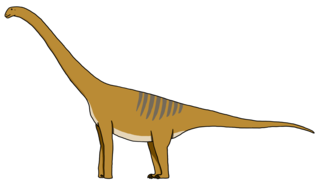
Arkharavia is a dubious genus of somphospondylan sauropod, but at least some of the remains probably belong to a hadrosaurid. It was discovered in the Udurchukan Formation in Russia and lived during the Late Cretaceous. It was described in 2010 by Alifanov and Bolotsky and the type species is A. heterocoelica.
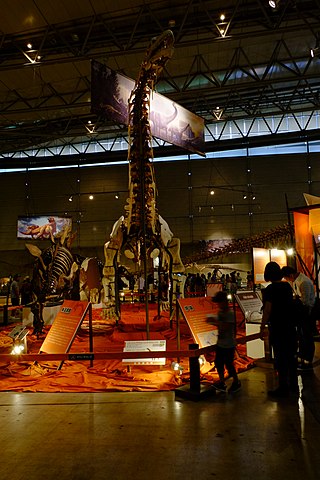
Xianshanosaurus is a genus of sauropod dinosaur from the Early Cretaceous (Aptian-Albian) of the Ruyang Basin in Henan Province, China. Its type and only species is Xianshanosaurus shijiagouensis. It was described in 2009 by a team of paleontologists led by Lü Junchang. Xianshanosaurus may be a titanosaur, and Daxiatitan may be its closest relative, but its evolutionary relationships remain controversial.
Liubangosaurus is a genus of sauropod dinosaur that lived during the Early Cretaceous in what is now China. The type and only species is Liubangosaurus hei, first described by Mo Jinyou, Xu Xing and Eric Buffetaut in 2010. Liubangosaurus is known from the holotype NHMG8152, five complete and articulated middle-caudal dorsal vertebrae that were collected from the Xinlong Formation in Fusui County, Guangxi Province. Mo et al. (2010) found that Liubangosaurus belonged to the clade Eusauropoda.
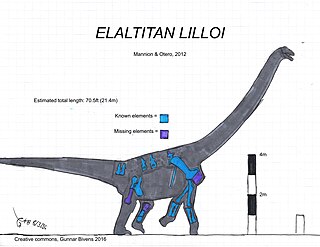
Elaltitan is an extinct genus of large lithostrotian titanosaur sauropod dinosaur known from the Late Cretaceous of Chubut Province, southern Argentina. It contains a single species, Elaltitan lilloi.
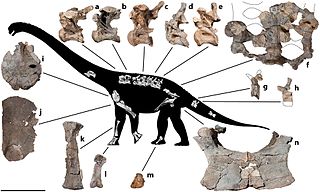
Savannasaurus is a genus of titanosaurian sauropod dinosaur from the Late Cretaceous Winton Formation of Queensland, Australia. It contains one species, Savannasaurus elliottorum, named in 2016 by Stephen Poropat and colleagues. The holotype and only known specimen, originally nicknamed "Wade", is the most complete specimen of an Australian sauropod, and is held at the Australian Age of Dinosaurs museum. Dinosaurs known from contemporary rocks include its close relative Diamantinasaurus and the theropod Australovenator; associated teeth suggest that Australovenator may have fed on the holotype specimen.
Triunfosaurus is a genus of somphospondylan sauropod dinosaur from the Early Cretaceous of Brazil. It contains a single species, T. leonardii, described by Carvalho et al. in 2017. As a genus, Triunfosaurus can be distinguished from all other titanosaurs by the unique proportions of its ischium. It was initially described as a basal titanosaur, making it the earliest basal titanosaur known; however, subsequent research questioned the identification of the taxon as a titanosaur, instead reassigning it to the Somphospondyli.

Mierasaurus is an extinct genus of sauropod dinosaur from the Early Cretaceous of Utah, United States. The taxon was first described and named in 2017 by Rafael Royo-Torres and colleagues, from a mostly complete skeleton including a disarticulated partial skull and mandible, teeth, multiple vertebrae from along the length of the body, both scapulae, radius and ulna bones, a left manus, a complete pelvis, both femora and the entire left hindlimb. Additionally, they referred a lower jaw and femur from juvenile individuals, which were found nearby, to the genus. Collectively, Mierasaurus is among the most completely known North American sauropods. The genus name honours Bernardo de Miera y Pacheco, the first European scientist to enter what is now Utah. The type species for Mierasaurus is Mierasaurus bobyoungi, named after Robert Glen Young, a paleontologist who researched the Early Cretaceous of Utah.
Ruixinia is an extinct genus of somphospondylan titanosauriform dinosaur from the Early Cretaceous (Barremian) Yixian Formation of China. The genus contains a single species, Ruixinia zhangi. The Ruixinia holotype is a partial articulated skeleton with the most complete series of caudal vertebrae known from any Asian titanosauriform.
